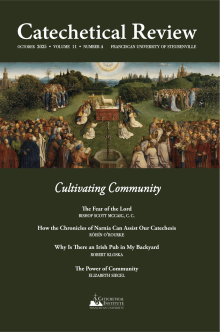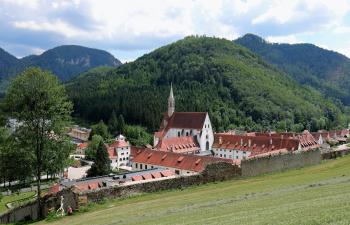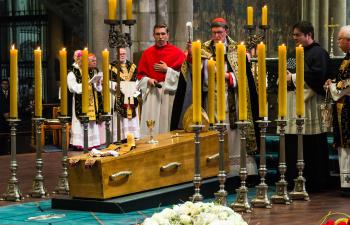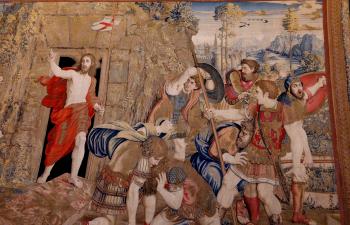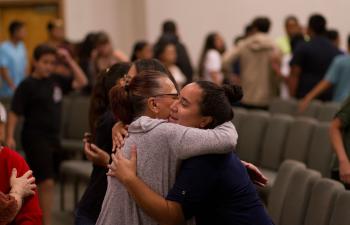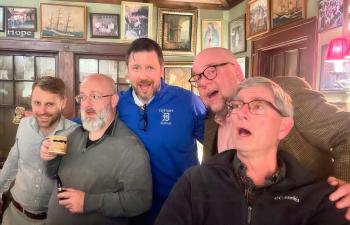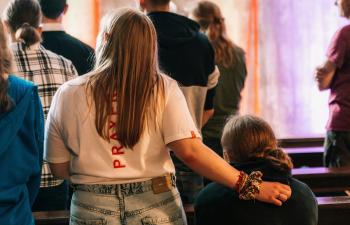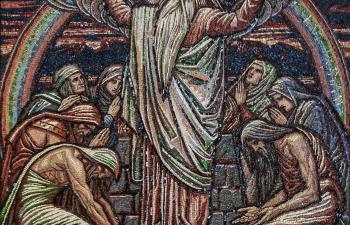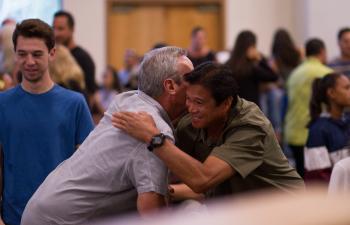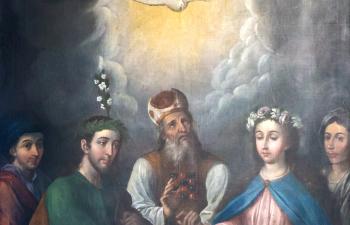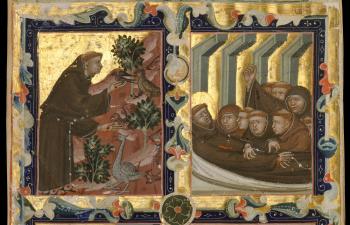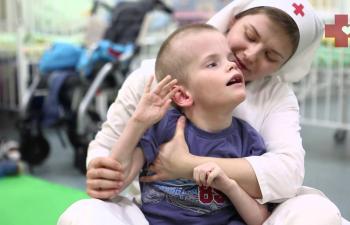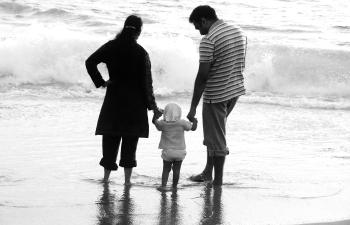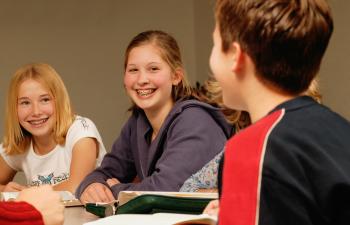The Church recognizes that every parish community includes members with disabilities and earnestly desires their active participation. . . . Catholic adults and children with disabilities, and their families, earnestly desire full and meaningful participation in the sacramental life of the Church.[1]
 The parish is where the local Church lives as family, called together by the Lord, amidst all the peace, goodness, beauty, joys, struggles, and sufferings of this world.[2] People with impairments belong in our families and parishes,[3] and the US bishops in their teaching about disciples with impairments and their families, highlight the essential role of the parish, the local and visible expression of the Eucharistic community.[4] This invitation to think not only about individuals but about the whole parish family is instructive and offers an opportunity to reimagine aspects of catechesis.
The parish is where the local Church lives as family, called together by the Lord, amidst all the peace, goodness, beauty, joys, struggles, and sufferings of this world.[2] People with impairments belong in our families and parishes,[3] and the US bishops in their teaching about disciples with impairments and their families, highlight the essential role of the parish, the local and visible expression of the Eucharistic community.[4] This invitation to think not only about individuals but about the whole parish family is instructive and offers an opportunity to reimagine aspects of catechesis.
Turning to the Directory for Catechesis, we similarly find an exposition of multiple facets of the parish and sacramental life, including emphases on: staying close to families of people with impairments, solidarity, inclusion, shared ministry, and a recognition that people with impairments are not passive but active members of the parish.[5] I suggest that the Directory also encourages us to consider that the above characteristics are to be grounded in a fraternal and deeply personal love embodied in close Christian community—not just on Sundays but on each day of the week and not only in parish buildings but wherever Christians gather. We might consider what such love in the parish could look like through four interrelated perspectives on the ordinary, conversion, friendship, and new life.
The Ordinary
While it may sound odd to phrase it this way, the parish is to be for us an ordinary environment—that is, a normative expression of our shared life as Church.[6] And in that sense, to the degree that human impairment is part of this world, we lose out on some of the richness of this ordinary life when those with impairments and their families are separated physically or socially from the parish, perhaps in subtle or unrecognized ways[7] (such as not being made welcome at Mass or at parish events or being left out of parish planning), and pushed behind forbidding walls of strangeness, to adapt a phrase from Miguel Romero.[8] In contrast, a family unity among Catholics with and without impairments, lived out in the Church and the parish, should be a quite ordinary and usual exercise of faith that simultaneously provides a profoundly attractive witness to fellow Christians and to the world.[9]
Such unity is a striking illustration of Pope Leo XIV’s motto: “In the One, we are one.” Working together as a parish family to overcome some of the social barriers and negative stereotypes surrounding impairment and impaired people is a beautiful mission consistent with the Gospel and the witness of the apostolic Church. The communal tasks of discovering and embracing each other’s gifts no matter how out of sight, of listening closely for new voices of peace no matter how muted, and of dismantling social walls no matter how high can help a parish to flourish as a community of love (1 Cor 12:4–11).
Imagine a parish breakfast at which it goes without saying that some enjoying the food and company need help with eating or with having a conversation. Picture a gift bearer at Sunday Mass whose speech is to some extent inarticulate as a result of a traumatic brain injury, or an altar server or lector who is a regular at the Sunday Mass but sometimes takes him- or herself off the schedule due to the cyclical nature of a psychiatric disorder, or a faith formation team with a catechetical leader who uses a wheelchair.[10] All this and more should be ordinary for the parish.
The rest of this online article is available for current Guild members.
[1] United States Conference of Catholic Bishops, Guidelines for the Celebration of the Sacraments with Persons with Disabilities, rev. ed. (USCCB, 2017), 1, https://www.usccb.org/resources/Guidelines-for-the-Celebration-of-the-Sacraments-with-Persons-with-Disabilities-Revised-Edition.pdf.
[2] This is one of the themes of the USCCB document Communities of Salt and Light: Reflections on the Social Mission of the Parish (USCCB, 1993), https://www.usccb.org/resources/communities-salt-and-light-reflections-social-mission-parish.
[3] See Jonathon L. Wiggins, Lavina Rodrigues, and Felice M. Goodwin, “Study of Parish Disability Awareness and Practices in the United States,” National Catholic Partnership on Disability, Center for Applied Research in the Apostolate, Georgetown University (October 2024), https://www.ncpd.org/files/file_uploads/Final_CARA_Report_NCPD_2024.pdf.
[4] The aforementioned 2017 Guidelines, for example, contain at least 13 substantive references to the parish. See also John Paul II, Christifideles Laici, no. 26.
[5] See Pontifical Council for the Promotion of the New Evangelization, Directory for Catechesis (USCCB, 2020), nos. 269–72; Pontifical Council for Justice and Peace, Compendium of the Social Doctrine of the Church (2004), no. 148.
[6] For a study of this point, see Wolf Wolfensberger, “The Normative Lack of Christian Communality in Local Congregations as the Central Obstacle to a Proper Relationship with Needy Members,” in W. Gaventa and D. Coulter, eds., The Theological Voice of Wolf Wolfensberger (Haworth Press, 2001), 113.
[7] United States Catholic Conference, Pastoral Statement of U.S. Catholic Bishops on People with Disabilities (1978), 1, https://www.usccb.org/beliefs-and-teachings/what-we-believe/catholic-social-teaching/upload/Pastoral-Statement-of-U-S-Catholic-Bishops-on-Persons-with-Disabilities.pdf.
[8] Miguel Romero eloquently expounded on this idea in a keynote presentation titled “Erasing the Wall of Strangeness,” given at the 16th annual Gospel of Life Prayer Breakfast hosted by Legatus, St. Louis Chapter, available online at https://www.youtube.com/watch?v=TtjpN0RVaoA.
[9] See Cardinal Pietro Parolin, “Message to the 41st Meeting for Friendship Among Peoples,” Rimini, August 5, 2020; Francis, “Address to Participants in the Convention for Persons with Disabilities Promoted by the Italian Episcopal Conference,” Vatican City, June 11, 2016.
[10] See Marc Tumeinski, “Just Peacemaking and the Lives of Vulnerable People,” Journal of Catholic Social Thought 20, no. 2 (2023): 347–66.
[11] Francis, “Message for the International Day of Persons with Disabilities,” Rome, November 20 , 2021.
[12] Congregation for the Clergy, “The Pastoral Conversion of the Parish Community
in the Service of the Evangelising Mission of the Church” (2020), no. 34, quoting Francis, Evangelii Gaudium, no. 26.
[13] Francis, “Message for International Day of Persons with Disabilities.”
[14] Wolf Wolfensberger, “How We Carry the Ministry with Handicapped Persons to the Parish Level,” in The Theological Voice of Wolf Wolfensberger, 88.
[15] United States Catholic Conference, Pastoral Statement on People with Disabilities, 4. I am not comfortable necessarily with the language of suffering used in this section of the document, but the point stands.
[16] Francis, “Address to Participants in the Conference Organized by the Pontifical Council for Promoting New Evangelization,” Vatican City, October 21, 2017.
[17] Francis, “Message for International Day of Persons with Disabilities.”
[18] Francis, “Address to Participants in the Conference.”
[19] See Marc Tumeinski and Jeff McNair, “What Would Be Better? Social Role Valorization and the Development of Ministry to Persons Affected by Disability,” Journal of the Christian Institute on Disability 1, no. 1 (2012): 11–22.
[20] Directory for Catechesis, no. 88.
[21] Directory for Catechesis, nos. 218, 303.
[22] Allyson Howell (Todd), “Intellectual Disabilities and The Church,” For the Church (blog), October 19, 2020, https://ftc.co/resource-library/blog-entries/intellectual-disabilities-and-the-church/.
[23] See Codex Iuris Canonici (Code of Canon Law), canon 843, §1; Directory for Catechesis, no. 272.
[24] Janice Benton, OFS, and Nancy Thompson, OCDS, “Making Room for Persons with Disabilities” (National Catholic Partnership on Disability, USCCB, 2015),
https://www.usccb.org/beliefs-and-teachings/how-we-teach/catechesis/catechetical-sunday/human-dignity/parish-resource-benton. See also Wolf Wolfensberger, “An Attempt Toward a Theology of Social Integration of Devalued/Handicapped People,” in The Theological Voice of Wolf Wolfensberger, 49–70.
[25] Francis, “Address to Participants in the Conference.”
[26] Brent Little, “A Charity of Mutuality and Hospitality: L’Arche’s Witness to Catholic Theology,” Horizons 47, no. 1 (2020): 46–68.
[27] This same lens is relevant to Catholic schools, a topic which merits its own study.
[28] Francis, “Message to Prof. Margaret Archer, President of the Pontifical Academy of Social Sciences,” Vatican City, April 24, 2017.
[29] Francis, “Message for the International Day of Persons with Disabilities,” Rome, December 3, 2022.
Art Credit: Sister of mercy takes care of a disabled child; Healing of the Paralytic at Capernaum, Wikimedia Commons.
This article originally appeared on pages 43 - 53 of the print edition.
This article is from The Catechetical Review (Online Edition ISSN 2379-6324) and may be copied for catechetical purposes only. It may not be reprinted in another published work without the permission of The Catechetical Review by contacting [email protected]


